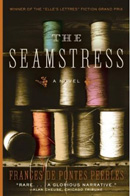


Bloomsbury, paperback, 9780747596868
Harper Perennial, paperback, 9780060738884
A tale of two sisters, The Seamstress may not be the 'perfect' debut novel but it certainly heralds an exciting new voice from South America. Set in Brazil in the period 1928 to 1935, this novel follows the lives of orphaned sisters, Emilia and Luzia dos Santos, who are brought up by their seamstress aunt Sofia in the isolated village of Taquaritinga do Norte. Sofia teaches both her nieces how to sew, and the sewing motif weaves itself in and out of the novel on both a literal and symbolic level.
Older sister Emilia is a conventional beauty who dreams of escaping to the city as the wife of a handsome, rich man while her younger sister Luzia simply dreams of freedom and autonomy. Tall and acerbic in manner, Luzia has a crippled left arm which has earned her the much hated nickname of Victrola (like the gramophone player). While neither of them understands what motivates the other, they both realize that there is no future for either of them in the village. In true fairy tale fashion Emilia unexpectedly meets her rich city man, Degas, on a dusty mountain trail. Luzia's escape from Taquaritinga is far more dramatic. She runs away with a band of rebels after meeting their charismatic leader, The Hawk.
Over the next seven years Luiza and Emilia are able to keep track of each other through the articles and photographs that appear in the national papers. Luiza has become the dreaded female bandit, The Seamstress, while Emilia is a society darling with her own fashion label. However both of them are only too aware that they are living on the edge of an abyss, both outsiders fighting for their own survival. For Emilia it has been a classic case of "be careful what you wish for" while for Luiza the life of a bandit queen is one fraught with self sacrifice at the deepest personal level.
Comparisons between de Pontes Peebles and Isabel Allende are inevitable. They both write sweeping family sagas, awash with details, and they both create intriguing characters. Even the minor characters, like Degas' parents, Dr Duarte and Dona Dulce, are people we want to know more about—but therein lies the weakness in The Seamstress. It's as if the author wanted to get too much into that first novel and as a result there is an over abundance of character, plot and information. The Seamstress would have been an even better novel if the seams had been taken in slightly.
While the reader will effortlessly absorb a good deal of Brazilian history by
reading The Seamstress, it is the relationship between Emi and Luiza that
is the key. The central "love" story is that between these two very different
women. It is in unveiling this relationship that de Pontes Peebles reveals her
strength and skills as a writer.